 While getting ready for my next backpacking trip, I came across a Campmor zipper pull, the last of a couple dozen I bought in the ‘80s. Campmor may not be a household name for many backpackers, so I thought I would share some history. The hit single Sweet Dreams (Are Made of This), was released by the British duo Eurythmics in 1983. 1983 was also the year Colin Fletcher’s The Complete Walker III was written. Walker III, along with Backpacker Magazine, put the mail order company Campmor on the map and in the minds of backpackers. A journey into the past. Sometimes we need to visit the past to understand the present and even predict the future.
While getting ready for my next backpacking trip, I came across a Campmor zipper pull, the last of a couple dozen I bought in the ‘80s. Campmor may not be a household name for many backpackers, so I thought I would share some history. The hit single Sweet Dreams (Are Made of This), was released by the British duo Eurythmics in 1983. 1983 was also the year Colin Fletcher’s The Complete Walker III was written. Walker III, along with Backpacker Magazine, put the mail order company Campmor on the map and in the minds of backpackers. A journey into the past. Sometimes we need to visit the past to understand the present and even predict the future.
Sweet Dreams
What does a song about dreams have to do with backpacking? Sweet Dreams (Are Made of These) is about the never-ending search for happiness. Today many use the Internet in their search for happiness. For some, simple entertainment such as YouTube or TikTok is a target for potential contentment, as is Social Media. Online shopping or “window” shopping fulfills this quest for happiness, though the perceived happiness is fleeting. Unfortunately the quest is never fulfilled, and like drugs, can simply lead to an addiction, not contentment or a good life.
Advertisers
Advertisers know how to plug into our search for happiness — if we let them. A 60 second commercial during the Super Bowl costs millions of dollars because people will buy the stuff showcased. Today the Internet is where most people go to for an initial search for goods, and for many it is a search for happiness, contentment, and a good life. Google is even running a TV ad stating that something like 90% of people do an initial search for products with their search engine. Oh, and Google searches are biased. Google knows what you are likely to buy and will serve up search results that maximize their profits. Same goes for Amazon. Even when you do a Google search, Amazon will be towards the top of the results list, with a paid advertisement. Do a search on Amazon and the first item will be for a product Amazon wants you to buy, not necessarily a good match for what you are looking for. Let us not forget that Google and Amazon are among the most valuable companies in the world. I’m not saying either are bad. I use both. But, “buyer beware” should be in your mind’s eye at all times. However, this post isn’t about Google or Amazon. It is about Campmor. Before we get more into Campmor, let’s take a trip into the past before the Internet had so much influence on our lives, in a time before the World Wide Web.
Catalogs and Websites
Although not as common as they once were, I still get the occasional printed catalog from RailRiders, Recreational Equipment Incorporated, and Patagonia. They are no different from catalogues of yesteryear, only the current ones don’t include a mail order form. You need to go to the company’s website to order. Just like a retailer’s website, these catalogs often picture equipment (such as tents) set up in the most awe inspiring locations on the planet. Clothing is presented by athletic looking beautiful women and handsome men. And just like them, you can find happiness with the same gear, equipment, or clothing. Win, win. You will find happiness (supposedly) with your new purchase and the company makes a profit from your money. And if you don’t find bliss, the company will be more than happy to sell you a new and improved model.
The Mail-Order Business
Aaron Montgomery Ward changed how Americans purchased goods when he started the first significant mail-order business (Montgomery Ward) in 1872. This was soon followed by Sears, Roebuck & Company in 1886. By 1906 Sears was distributing over one million mail-order catalogs a year.
The Backpacking Mail-Order Business
I started backpacking as a teenager in the 1960s. I bought gear from Army-Navy Surplus stores, department stores, general sporting goods stores, and swap meets. There were a few backpacking equipment manufacturers that sold via mail order, but how was one to even know about them? Mostly word of mouth, as there were not any magazines or other media to reach the general population. Unfortunately there weren’t any specialty shops near my home, or else I didn’t know they existed. But guess what? I was happy with my cheap gear because the focus was on my backpacking trips, gear was a secondary thought. If something worked and didn’t fail on a trip, I was happy. During this time there were gear manufacturers that did sell their products directly to the public via mail-order, but how was I do find them? There were no backpacking-centric magazines and Al Gore wouldn’t invent the Internet for a couple decades or so to come. An example is Kelty backpacks who apparently did a robust mail order business starting in the 1950s. 
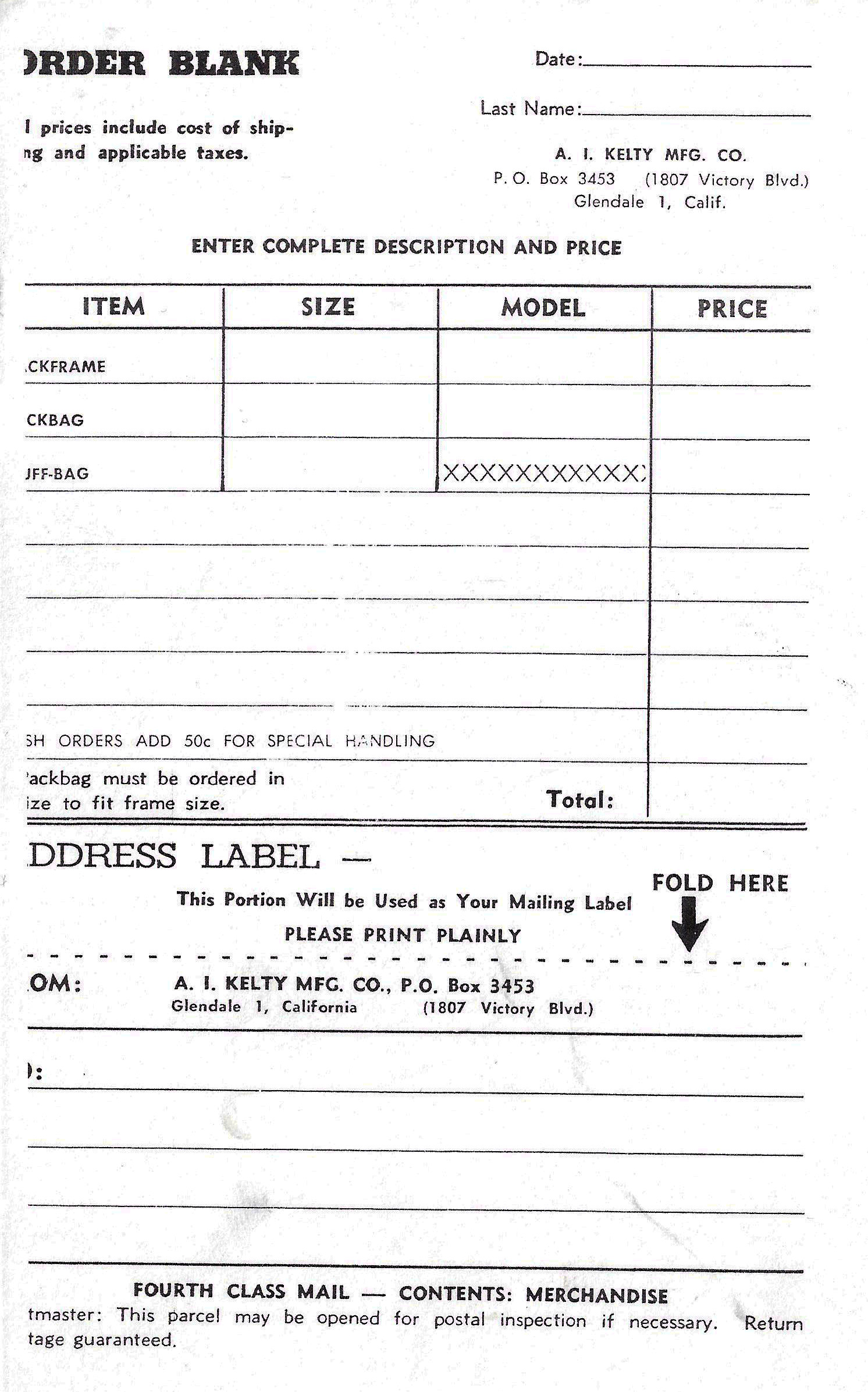 In 1971 when I got out of the military, I bought a complete gear set up in the small city of Fresno, California. Being close to the Sierra Nevada, it was a gem of a store. In those days, one pretty much had to stumble accidentally upon a retailer who sold quality gear and stocked a large inventory of everything a backpacker would need.
In 1971 when I got out of the military, I bought a complete gear set up in the small city of Fresno, California. Being close to the Sierra Nevada, it was a gem of a store. In those days, one pretty much had to stumble accidentally upon a retailer who sold quality gear and stocked a large inventory of everything a backpacker would need.
The Complete Walker
All of this changed when Colin Fletcher published the Complete Walker in 1968. More than any person in the US, Fletcher helped popularized backpacking. He was so influential that if he used a product, demand would quickly overwhelm supply. His influence made the Svea 123 stove, Sigg Cookware, Trailwise backpacks, Pivetta boots, and other equipment must haves for large numbers of backpackers. Fletcher’s impact was so powerful, that he almost single-handedly killed the external-frame backpack when, in the third edition of his series of backpacking books, The Complete Walker III, he revealed he had switched from his beloved Trailwise external-frame pack to a Gregory Cassin internal-frame pack. External frame packs quit selling and Wayne Gregory became rich. Not only did he present the current state of the market, but included an index of mail order companies in the first three editions. He did not include such a list in the final fourth edition (2002) as mail-order was mostly dead, replaced by the Internet. Fletcher’s books are a backpacking historical time capsule, as much didn’t actually change in regards to backpacking from 1968 to 2002 (over even today), other than each year more and more gear was available for those who seek backpacking happiness. Thus, each edition got larger and larger with all the current gear to review and comment on. What follows is a summary of the three editions, with the number of pages, the “four star” mail-companies that as he wrote “ * * * * means ‘just about everything a backpacker could want, and a wide choice.’ “ I will only include US retailers even though he presented retailers in Canada too.
The Complete Walker (1968, 345 pages)
**** Four Star Mail-Order Retailers
- The Ski Hut (aka Trailwise), also had one retail store in California
- Recreational Equipment, Inc (REI), also had two retail stores in the state of Washington
The New Complete Walker (1974, 470 pages)
**** Four Star Mail-Order Retailers
- Eastern Mountain Sports, also had two retail stores (NY and Mass)
- Holubar Mountaineering, also had three retail stores in Colorado
- The Ski Hut (aka Trailwise), also had one retail store in California
- Recreational Equipment, Inc (REI), also had two retail stores in the state of Washington
The Complete Walker III (1984, 668 pages)
**** Four Star Mail-Order Retailers
- Campmor, also had one retail store in New Jersey
- Eastern Mountain Sports, also had two retail stores (NY and Mass)
- Holubar Mountaineering, also had three retail stores in Colorado
- The Ski Hut (aka Trailwise), also had one retail store in California
- Recreational Equipment, Inc (REI), also had eight retail stores in several states
The Complete Walker IV (2002, 884 pages)
In 2001, at the age of 79, Fletcher was seriously injured when a SUV ran over him on a road. I don’t know the timeline of when he was exactly working on the book, but by now he was not backpacking much and solicited the assistance of a co-writer, Chip Rawlins, to cover the newer gear. No longer was a list of mail order retailers included. On another note, much was lost of Fletcher’s captivating writing style with the addition of Rawlins, and the book suffered because of it. But even today, the first three editions are excellent reading.
Backpacker Magazine
The first issue was published in 1973. For a few years, until purchased by a conglomerate, Backpacker had excellent gear reviews and a policy of not sharing the location details of great backpacking trips. Of course this changed under new ownership. Backpacker has been purchased by a several other large media companies in the ensuing years. But in the ‘70s and ‘80s Backpacker was the source for unbiased gear reviews, techniques, and information about gear manufacturers. Sprinkled throughout the magazine were ads for mail-order catalogues; some free and some some of nominal cost, such as pay only the postage, 25 cents up to a dollar. Just clip the ad, send a check to the company and wait for your catalogue to arrive. Backpacker, like many magazines of the time, also included a Reader Service Card in each issue. Just circle the companies you wanted a free catalog from and mail the card to Backpacker. The requested catalogs would be forwarded to the appropriate company and soon (or later) you received a catalog in the mail. It was much quicker to contact the companies directly.
Campmor
Well, we’re finally back on topic. The company was founded in 1978 and is still privately owned. All this time, they’ve had one retail store in Paramus, NY on Route 17. The store is huge and well stocked, with a knowledgeable staff. Located fairly close the Appalachian Trail, the store is convenient to thru-hikers. I’ve stopped by the store on a couple occasions when section hiking this part of the trail. By the mid ‘80s (probably after the publication of Complete Walker III) along with the plethora of printed ads in Backpacker Magazine, Campmor was a favorite with many backpackers. And for good reason: very competitive prices, a comprehensive mail order catalog, and quick shipping. I’ve been a Campmor fan since the ‘80s and bought quite a bit a gear and clothing from them over the years. I still use them occasionally. Occasionally meaning I only occasionally need to buy new stuff. All my old stuff works just fine and nowadays I mostly just purchase things when something wears out.
The Campmor Catalog
Below is a sample catalog. I used to get them automatically, being on their mailing list. Campmor no longer prints catalogue, in submission to the almighty Internet. 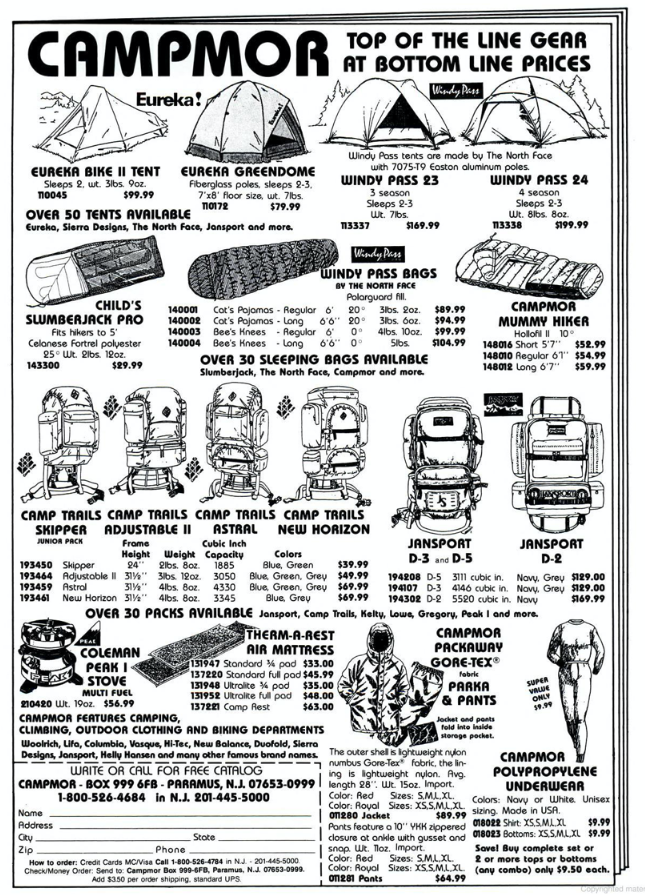 No fancy pictures in mountain settings or well dressed models, the catalogues were illustrated. What was important, back then, is every item included an accurate weight. If there were several sizes, the weight of each size was stated. Over 60 pages crammed full of great gear with a comprehensive index at the back. Shipping was a flat $3.50 for any order, delivered promptly by UPS. For “lightweight” back backpackers (sorry folks, Ray Jardine did not invent lightweight backpacking) the catalogue was a reference bible of backpacking gear. Of course there was an order form in the catalog to order by mail, or you could just call and an expert employee would answer all your questions and take your order over the phone if you wanted. How convenient!!
No fancy pictures in mountain settings or well dressed models, the catalogues were illustrated. What was important, back then, is every item included an accurate weight. If there were several sizes, the weight of each size was stated. Over 60 pages crammed full of great gear with a comprehensive index at the back. Shipping was a flat $3.50 for any order, delivered promptly by UPS. For “lightweight” back backpackers (sorry folks, Ray Jardine did not invent lightweight backpacking) the catalogue was a reference bible of backpacking gear. Of course there was an order form in the catalog to order by mail, or you could just call and an expert employee would answer all your questions and take your order over the phone if you wanted. How convenient!! 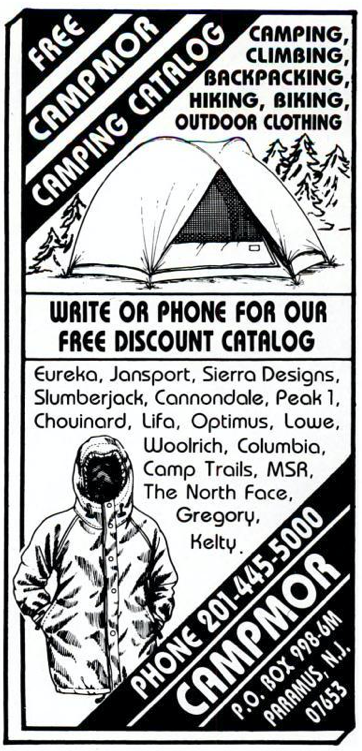 In the Complete Walker III, Fletcher wrote this about the Campmor mail-order catalogue:
In the Complete Walker III, Fletcher wrote this about the Campmor mail-order catalogue:
Free, unfancy catalogue is probably the most complete and comprehensive indexed around.
1970s and 1980s Campmor Ads from Backpacker Magazine
Order a catalogue. Note that this is from 1979 in the back of the magazine.  Camping Equipment Listing. Campmor is the 4th listing.
Camping Equipment Listing. Campmor is the 4th listing. 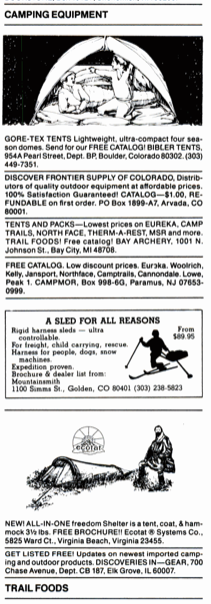 Order a catalogue directly from Campmor.
Order a catalogue directly from Campmor. 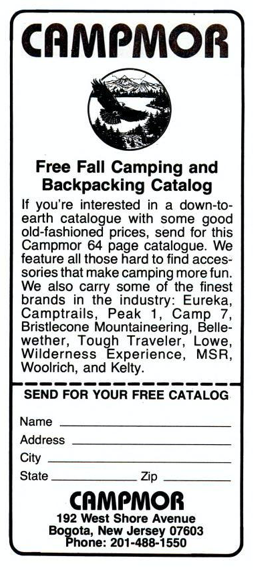
Competitive Prices
Today, as in the ‘70s and ‘80s, Campmor prices are competitive. A popular stove today is the MSR Whisperlite Universal. Below are links to several retailers with today’s (January 12, 2022) price for the stove. MSR Whisperlite Universal Cost Comparison Click on any link to view.
This post contains affiliate links. If you purchase an item via a link there is no additional cost and I get a small commission that goes to the cost of hosting the blog.